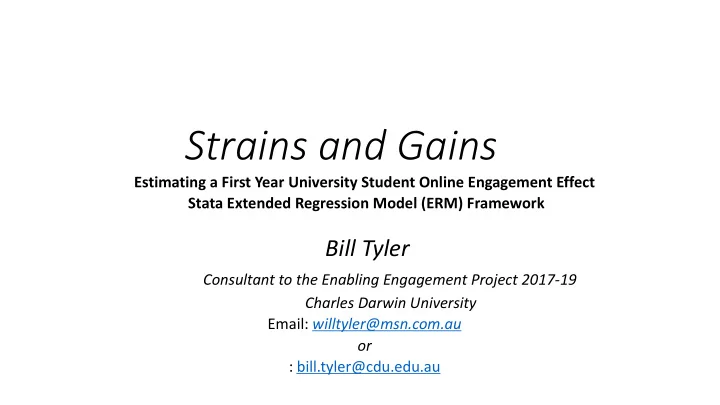

Strains and Gains Estimating a First Year University Student Online Engagement Effect Stata Extended Regression Model (ERM) Framework Bill Tyler Consultant to the Enabling Engagement Project 2017-19 Charles Darwin University Email: willtyler@msn.com.au or : bill.tyler@cdu.edu.au
Enabling Engagement : Contexts and Questions This paper addresses three main issue s : • Do reported levels of online engagement of First Year enrolments predict the Numerical Grades Awarded? • Can an ERM “wash out” the endogenous effects of covariate bias, sample selection in estimation of an “engagement effect? • What are the strengths and weaknesses of the Extended Regression Modelling (ERM) framework in evaluation research for HE innovation?
Policy and Performance The Rise of “Distributed Learning”
Diversity and Delivery: the CDU Context The Externalisation of Course Delivery
The Flexi xible Learning Response: Phasing in Online Delivery at CDU
Th The Resear arch Questio ions: Onlin line Activit ivity an and Student Success I. Do increased levels of online activity exert a uniform and positive effect on grade levels, after “confounding “ variables (student background and admission entry categories are controlled? II. Does an effect (sign, size, significance) also depend on learning context- External Mode, Part-time Status or Unit Type (Common Unit or Core Unit)? III. How might we infer a causal effect for exposure to and participation in online participation on student grades?
Es Esti timati ting ng Onl nline ne Effect: t: From Regr gressi ssion n to Causa usal Inferenc nce
Th The S Sample: O Outcom ome, “ “Treatment” & Con & Confou ounders
Regression Results: Linear and Non-Linear
De Developi ping ng an n Ex Extende nded d Regression n Mo Model el* The term “endogenous” is used most frequently to encompass the distorting confounding or “non-ignorable” effects of : • endogenous covariates : where a background variable which may have a confounding effect on response to a treatment. These need to be included in the estimation (cf Analysis of Covariance). • sample selection : where the participants in such a trial were overwhelmingly drawn from a non-representative group of the target population (e.g. in the weightloss example, from a group that had a history of chronic eating disorders); • treatment assignment : where those who were assigned to the treatment group rather than the ‘control’ or non-treatment group were unbalanced across one or more critical dimensions (e.g. on ethnicity, age or gender ). *Users are referred to similar ERM model for estimating an intervention effect for a “Fictional University” in Chuck Huber’s presentation at this Conference, available at https://tinyurl.com/2019CausalInference
Estimating Online Effect: A Generic Framework
Bu Building g an an ERM of Online nline Eng ngag agement t Effect These three sources of endogeneity will be addressed within an Extended Regression Modelling framework. Each is followed by a research question of practical interest: • Endogenous covariates In this model two covariates, Part-time Status (defined as an EFTSL score below .375 or one or two units associated with each enrolment per semester) and External Mode of Attendance, are identified as endogenous. • Sample Selection Bias The status of the lowest scoring group (FNS/DNS)* in the scale of Grade Awarded outcomes raises an important issue of endogeneity that precedes that of treatment assignment or levels of engagement. These were treated by a Heckman-type selection model (similar to Chuck Huber’s use of the same approach for missing data). • Endogeneity in Assignment to Treatment - in a self-selection design, recognises that : i. more motivated and committed students will be more likely to have higher activity scores than others, even after adjustment self select to a level of online engagement; ii. conversely, lower ability students who are more at risk of attrition or failure may be more likely to rely on the resources and support offered by Blackboard and other systems.
So Sourcin ing En Endogeneit ity : Co Covariate, , Engagement and Sample Se Sele lectio ion* * ”engage_strat5a” is multivalued “treatment”variable defined as a five-level grouping of of the means of three Learnline activity zscores. “gradescale2” and “graded_3plus” are the dependent variables for the full sample (includes the DNS/FNS grades )and the “selected” sample (excludes the DNS/FNS) respectively.
Po Potential Grades at Five Levels of Online Eng Engageme ment* t* n= n=4,978 obser ervations ns (standa ndard d er error adj djus usted ed for 3,192 clus uster ers) *Blackboard Learnline Activity scores – Learnline is a compulsory learning system for all enrolments
Potential vs Observed Outcomes
Potential Gains: Indigenous Enrolments by Attendance Status
“Strains and Gains”: a Summary Strains • Causal attribution requires more sensitive discriminators for exposure vs participation when “treatment” (level of online engagemnt) is either compulsory or universal. • Multivalued treatment scoring may complicate estimates of marginals and contrasts. • Lack of multiway vce (cluster) restricts levels of “nested” effects estimation. Gains • ERM Release 15 provides consistent estimators in a complex Higher Education valuation research. • Combined auxilliary equations (with eregress) can reproduce the non-linear fit of an OLS cubic expansion. • Positive treatment effects of online engagement are unevenly distributed, with highest potential “gains” at the lower end of observed grade distribution.
Recommend
More recommend